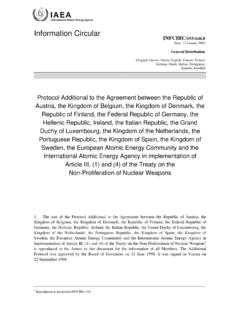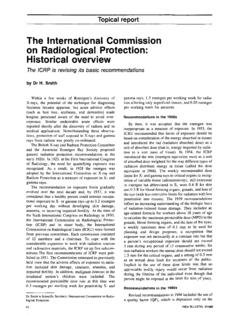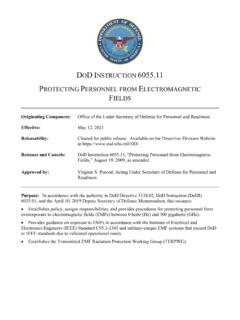Transcription of 12 16881 NE brochure forWEB - International Atomic Energy ...
1 Getting to the Core of Environmental Remediation Reducing radiation exposure from contaminated areas to protect people Getting to the Core of Environmental Remediation Taking care of the environment today is a sustainable act for the generations of tomorrow. Avoiding the need for excessive remediation programmes after the end of operations is a fundamental aspect of life cycle thinking of any nuclear facility or industry handling radioactive material. Before This brochure provides general information about environmental remediation areas, from planning to the implementation of remediation projects, including stakeholder involvement, which is an important factor for the successful completion of remediation projects.
2 Content What to Consider When Defining Remediation Approaches 3. How Clean Is Clean'? 5. Stakeholders' Input Matters 5. Key Aspects to Take into Account 6. The Things to Know about Environmental Remediation 8..after remediation (photo courtesy of Wismut, Germany). Getting to the Core of Environmental Remediation Environmental remediation refers to reducing radiation exposure, for example, from contaminated soil, groundwater or surface water. The purpose is more than just eliminating radiation sources; it is about protecting people and the environment against potential harmful effects from exposure to ionizing radiation. In the past, many nuclear activities were developed without appropriate consideration of their environmental aspects and impacts.
3 Operations were run in situations in which laws and regulations did not exist or if they did, they were neither adequate nor comprehensive enough. As a result, radiologically contaminated sites were created. Such sites have also been created by nuclear and radiological accidents, as well as by non- nuclear industries in which human activities have increased the potential for exposure from naturally occurring radioactive materials compared to the unaltered state. As contaminated sites can ultimately lead to undesired health effects for local people, appropriate actions must be taken. Remediation of contaminated land areas or other contaminated media, such as surface or groundwater is applied in two ways: (1) By applying actions to the contamination itself.
4 This can lead to isolation, immobilization or removal of the actual source of radiation, for example by means of decontaminating areas, surfaces and environmental media. (2) Evaluating risks related to radiation exposure to people and thinking of ways of breaking the pathways between the radiation source and people. This approach might lead to evacuation, area isolation or changing land use and the local population's living habits. The two ways are complementary. When deciding on the actual remediation work, several different factors need to be taken into account. As every site has its own characteristics, there is no simple quick fix. The most important thing is to understand that remediation actions need to be justified and optimized the adopted actions must do more good than harm.
5 For example, increased radiation levels do not necessarily mean that the increase is harmful; some living environments have inherently high radiation levels. Thus, evacuating or isolating areas without firm scientific grounds for it can needlessly cause distress to the people it concerns. 2. Returning a contaminated site to its original state is often neither necessary Environmental nor possible. While environmental remediation aims to reduce radiation exposure to protect people, remediated sites can still be used for various remediation is usually purposes, for example, industrial operations and even housing. not an urgent task, thus enabling proper planning which is an essential What to Consider When Defining aspect of any remediation Remediation Approaches work.
6 Remediation should not be confused with an emergency response after an accident, and thus it usually does not require urgent actions. For this reason, thorough evaluation of the situation and formulation of the desired goal is not only possible but a prerequisite. Proper planning is an Thorough characterization of a contaminated site is a prerequisite of any environmental remediation project. 3. Getting to the Core of Environmental Remediation essential aspect of any remediation work in order to reach the justified and optimized end state of the site. Remediation actions The issues to be taken into account in the decision making process vary from technical to economic and social considerations, such as: need to be justified Radiation risk to the population due to the land use this is derived and optimized.
7 The from the exposure assessment of people to radioactive materials in the end result is always a site;. balance between risks, Occupational exposure due to remediation works workers will also be exposed during the remediation works;. costs, benefits and Net benefits of the remediation works to the affected community . remediation viability. remediation should do more good than harm;. Waste generation from remediation remediation is generally a waste generating activity, and the amounts and properties of generated wastes need to be considered in the decision making process;. Ethical issues remediation may affect people's lives and their living environment, including how they live.
8 Environmental remediation may generate radioactive waste that needs to be managed. 4. Financial costs of remediation remediation work costs are generally high and, therefore, financing mechanisms need to be sought;. Other non-radiological risks incurred sites to be remediated may not be contaminated only by radionuclides but also by other non-radioactive substances such as heavy metals and hazardous organic compounds. As every country is different and every site has its own characteristics, choosing the best possible environmental remediation solution means balancing between risks, costs, benefits and available technologies as well as public acceptance. How Clean Is Clean'?
9 The people, whose lives a contaminated site might affect, often have three fundamental questions in their mind: Is it safe for me and my family to live here? Who is responsible for this? Who is going to cover the expenses of the remediation works? Without national policies, liability issues for the remediation are not addressed and it is unclear which parties are responsible for implementing the remediation works. In addition, the important question of who will pay for the remediation is not unequivocally answered. National policy and strategies set up societal values regarding the environment and the population. Policy and strategies for implementing remediation need to be complemented by a consistent and well dimensioned regulatory framework.
10 Regulations define in detail how clean clean is', the requirements that will need to be met in each given situation; the level of site characterization to be accepted before and after the remediation works; and the acceptable end state of the site. The overall process should be transparent, be communicated to the relevant stakeholders and allow for their participation in the decision making process. Stakeholders' Input Matters An important factor for a successful remediation project is for those people whose lives are affected by the contaminated site to be involved in and to contribute to the remediation process as they have a stake in the end result. It is not only an ethical matter but a moral obligation to involve various stakeholders in the remediation process.


















